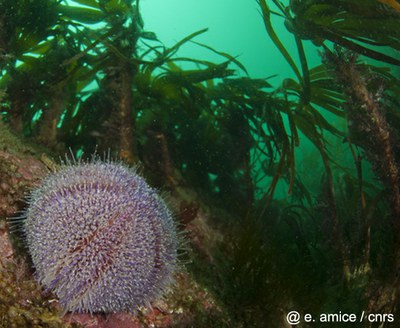5.5.4 Parc Naturel Marin d'Iroise: Aims of the Ecosystem Services Assessment

 In the Iroise sea, two kelp species (Laminaria hyperborea and Laminaria digitata) are significant species playing a key role both as habitat provider and primary producer on the rocky shore of these cold marine waters. Being very productive and important in terms of biodiversity (more than 300 taxa), the kelp forests are equivalent of coral reefs for the temperate coastal environment.
In the Iroise sea, two kelp species (Laminaria hyperborea and Laminaria digitata) are significant species playing a key role both as habitat provider and primary producer on the rocky shore of these cold marine waters. Being very productive and important in terms of biodiversity (more than 300 taxa), the kelp forests are equivalent of coral reefs for the temperate coastal environment.
Several species of European interest are found in this habitat. There are 150,000 Grey Seals in the Celtic Sea and 200 individuals in the Molène archipelago.
This species coexists well with seaweed harvesting, which is not the case of the Common Bottlenose Dolphin (12,000 individuals in the Celtic Sea and 60 in the Molène archipelago), which is very sensitive to noise. Since 1992, an evolution in the bottlenose group behavior has been observed, and they now seem to gather in the south of the archipelago where seaweed-harvesting effort is less important.
Kelp fields have been harvested in this area since the 19th century. Once required for the glass manufacturing industry then the iodine production, kelp is today sought for its alginate content. 60% of French kelp production is directly undertaken in the Molène’s archipelago and it supplies the demand of the animal feed, pharmaceutical and cosmetics industries.
Due to the recent introduction of the comb for L. hyperborea harvesting in Iroise and its strong impact on biodiversity and habitat structure, the use of this particular gear is debated within certain users groups (fishermen, recreational anglers) and managers concerned with conservation.
The management of the L. hyperborea fishery based on harvesting areas was negotiated and implemented fifteen years ago with kelp harvesters and is based on rotating harvesting zones and quotas. In a context of increasing demand of kelp (hyperborean spp.), the main objective of the Parc Naturel Marin d'Iroise, through the Ecosystem Services Approach, is to provide new insights to the current management debate and for the identification of new trade-offs.
The aim is to achieve precise management of the kelp field so as to allow a sustainable maximum yield for fishermen; an increase in employment linked to kelp harvesting and one that protects valuable species such as the Common Bottlenose Dolphin.
The question that the Parc Naturel Marin d'Iroise is trying to answer through the VALMER project is “How do we manage the kelp forest in the best way to conserve the kelp and allow its sustainable harvesting by fishermen?”.

The Parc Naturel Marin d'Iroise wished to define the best management measures for the kelp forest that will:
- identify the marine ecological functions and services linked to the kelp forest habitat
- identify the main pressures on the kelp forest habitat
- evaluate the long-term effects of the pressures on the functioning of kelp forest habitat

